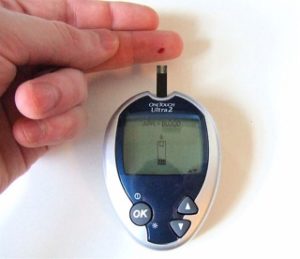Do you suspect you have thyroid or hormone imbalances and also struggle with being sleepy after eating (or always hungry)? You may suffer from insulin resistance, which raises your risk for diabetes. There’s good news, though … the same simple dietary and exercise tips that reverse insulin resistance can also help you manage your thyroid and hormone levels!
 If you have thyroid disease, how do you know if you also have insulin resistance? See if any of these symptoms apply to you:
If you have thyroid disease, how do you know if you also have insulin resistance? See if any of these symptoms apply to you:
- Fatigue after meals
- General fatigue
- Constant hunger
- Craving for sweets not relieved by eating them
- Must have sweets after meals
- Waist girth equal to or larger than hip girth
- Frequent urination
- Increased appetite and thirst
- Difficulty losing weight
- Migrating aches and pains
- Trouble falling asleep
Why is insulin resistance dangerous when you have hormone or thyroid disease?
Insulin resistance, also known as pre-diabetes, is uncomfortable, but it’s also dangerous. It is linked with Alzheimer’s disease, heart disease, chronic pain, hormone imbalances, and many other common modern maladies. It also triggers and exacerbates autoimmune diseases such as Hashimoto’s.
But that’s not all. Insulin resistance can kill your libido and make you chronically tired, on top of the havoc unmanaged thyroid disease is already causing.
If you’re a woman, insulin resistance causes testosterone to spike so you lose your hair and develop male characteristics. If you’re a man, it raises estrogen levels so you get “moobs” and cry at commercials. These are some pretty undesirable consequences for a sugar habit and unnecessarily worsens your autoimmune condition.
What causes insulin resistance?
The good news and the bad news is insulin resistance is caused by poor diet and lack of exercise. This is bad news because it means giving up some comforts, but it’s good news because it means radically changing your health is highly doable! Addressing just these two areas can help you make profound strides in managing your symptoms.
A diet high in sugars and carbohydrates—sugars, sweets, sodas, pastries, bread, pasta, rice, potatoes, corn, grains, beans, and other starchy foods —leads to high blood sugar and insulin resistance.
Because high blood sugar is dangerous to the body, the pancreas secretes insulin to lower it. Insulin escorts sugar out of the bloodstream and into the body’s cells. Excess sugar is converted into fat for storage.
When this response happens regularly, as it does for millions of Americans, the cells become overwhelmed from the constant bombardment of insulin. In defense, they become resistant to insulin and refuse it entry. Now you have high blood sugar and high insulin in your bloodstream, causing inflammation, throwing off hormone balance, degenerating the brain, and making it difficult to impossible to manage painful symptoms.
This is why insulin resistance causes fatigue after meals. The insulin-resistant cells are deprived of glucose for energy, converting all that extra sugar into fat is draining, and the whole process saps brain function.
Many people have both insulin resistance and low blood sugar. This means their energy crashes not only after meals, but between meals too. Either way, stabilizing blood sugar is your key to managing your condition.
Reversing insulin resistance and managing your thyroid
The most important thing is to ditch the sugar and eat only as many complex carbohydrates as your body needs (it varies from person to person). Eat tons of veggies for fiber and to build good gut bacteria. Start checking your fasting blood sugar in the morning and shoot for a level between 80 and 100. Anything over 100 is too high. Also, exercise daily, with bursts of high intensity and some weight training, to sensitize your cells to insulin.
These tips will also go a long way in helping you manage your condition.
Various herbs and nutrients can help reverse insulin resistance — contact our team for a blood test to see where you stand and recommendations to start healing!





